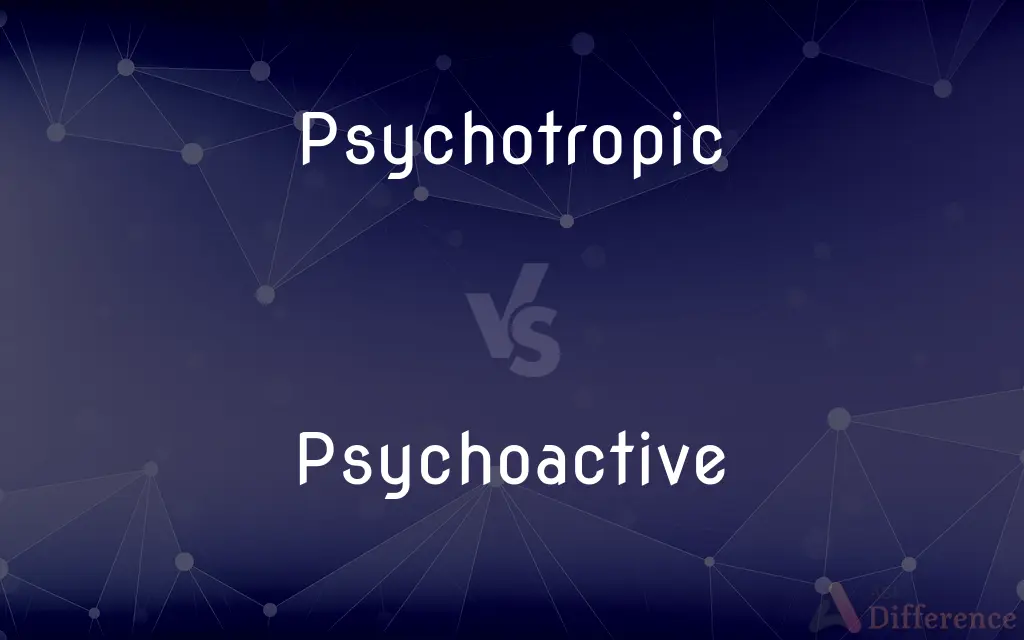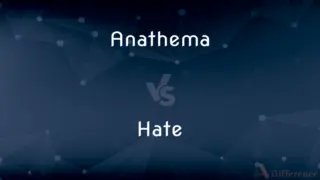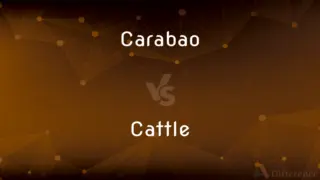Psychotropic vs. Psychoactive — What's the Difference?
By Fiza Rafique & Maham Liaqat — Updated on March 19, 2024
Psychotropic drugs specifically alter brain function to affect mood and behavior, while psychoactive substances encompass any chemical that affects the brain, including those outside medical use.

Difference Between Psychotropic and Psychoactive
Table of Contents
ADVERTISEMENT
Key Differences
Psychotropic drugs are a subset of psychoactive substances designed to treat psychiatric disorders by altering brain function, affecting mood, cognition, and behavior. In contrast, psychoactive substances include not only medical drugs but also recreational drugs, stimulants, and hallucinogens that affect mental processes.
While psychotropic drugs are used under medical supervision to manage conditions such as depression, anxiety, and schizophrenia, psychoactive substances can range from caffeine and alcohol to marijuana and LSD, used for various purposes including recreation, ritual, or enhancement of physical and mental performance.
The term psychotropic often implies a therapeutic intention, focusing on the treatment and management of mental health conditions. On the other hand, psychoactive is a broader term that encompasses any substance affecting the brain's chemical processes, regardless of its use or effects on health.
Regulation and control differ significantly between the two categories; psychotropic drugs are typically subject to strict prescription guidelines and regulatory oversight due to their potent effects and potential for misuse. Meanwhile, the legal status and regulation of psychoactive substances vary widely, from legal commodities like caffeine and alcohol to controlled substances under international narcotics laws.
Despite their differences, both psychotropic and psychoactive substances interact with the brain's neurotransmitter systems, but the specificity, purposes, and contexts of their use distinguish them. Psychotropic drugs aim to correct or manage specific psychiatric symptoms, while the use of psychoactive substances can have a wide range of motivations and outcomes, not solely focused on therapeutic effects.
ADVERTISEMENT
Comparison Chart
Definition
Drugs designed to treat psychiatric conditions by altering brain function, affecting mood and behavior.
Any chemical that affects the brain, including those used for medical, recreational, or spiritual purposes.
Purpose
Therapeutic, aimed at managing mental health disorders.
Varied, including recreational, therapeutic, enhancement, and spiritual experiences.
Types
Antidepressants, antipsychotics, mood stabilizers.
Includes psychotropic drugs, plus alcohol, caffeine, nicotine, cannabis, hallucinogens.
Regulation
Strict prescription guidelines and regulatory oversight.
Varies widely, from legal and regulated (e.g., caffeine, alcohol) to illegal and controlled substances.
Primary Effect
Alter mood, cognition, and behavior to treat specific psychiatric conditions.
Affect mental processes, with effects ranging from stimulation to hallucination, regardless of therapeutic intent.
Use Context
Medical, under supervision for mental health treatment.
Broad, including medical, recreational, ritualistic, and performance enhancement.
Compare with Definitions
Psychotropic
Relating to drugs that affect a person's mental state.
The doctor prescribed a psychotropic medication to help manage her depression.
Psychoactive
Pertaining to substances that affect the mind.
Psychoactive drugs, such as caffeine and alcohol, are widely consumed around the world.
Psychotropic
Used to treat psychiatric disorders and conditions.
Psychotropic drugs like antipsychotics are critical in treating schizophrenia.
Psychoactive
Affecting mood, perception, or consciousness.
The artist experimented with psychoactive substances to enhance creativity.
Psychotropic
Intended for the management of mood disorders.
The patient's mood swings were moderated with the help of psychotropic therapy.
Psychoactive
Including all drugs that can alter brain chemistry.
The study examined the effects of various psychoactive substances on cognitive performance.
Psychotropic
Capable of altering mood, perception, or brain function.
Certain psychotropic substances are used under strict medical supervision.
Psychoactive
Used for both medical and recreational purposes.
Some psychoactive plants have been used in traditional medicine for centuries.
Psychotropic
Drugs that influence psychological functions.
The conference on mental health discussed the development of new psychotropic compounds.
Psychoactive
Broad category of mind-altering substances.
The debate on the legalization of certain psychoactive drugs continues.
Psychotropic
Having an altering effect on perception, emotion, or behavior. Used especially of a drug.
Psychoactive
Affecting the mind or mental processes. Used of a drug.
Psychotropic
A psychotropic drug or other agent.
Psychoactive
(pharmaceutical effect) Affecting the mind or mental processes.
LSD and DMT are psychoactive drugs.
Psychotropic
(pharmaceutical effect) Affecting the mind or mental processes.
Psychoactive
(pharmaceutical drug) Any drug that affects the mind or mental processes.
LSD and DMT are psychoactives.
Psychotropic
(pharmaceutical drug) A psychotropic drug or agent.
Psychoactive
Affecting the mind or mood or other mental processes;
Psychoactive drugs
Psychotropic
Affecting the mind or mood or other mental processes;
Psychoactive drugs
Common Curiosities
How do psychotropic drugs work?
Psychotropic drugs work by altering the chemical balance in the brain to manage specific psychiatric conditions.
Why are psychoactive substances regulated differently?
The regulation depends on the substance's potential for abuse, health risks, and accepted medical use.
Can a drug be both psychotropic and psychoactive?
Yes, all psychotropic drugs are psychoactive, but not all psychoactive substances are used as psychotropic medication.
Are psychoactive substances always illegal?
No, the legal status of psychoactive substances varies widely, from legal substances like caffeine and alcohol to controlled substances like cannabis and LSD.
Is alcohol considered a psychoactive or psychotropic substance?
Alcohol is considered a psychoactive substance due to its effects on the brain, but it is not classified as a psychotropic drug, as it is not primarily used to treat psychiatric conditions.
What are the risks of using psychotropic drugs without supervision?
Uns supervised use of psychotropic drugs can lead to serious side effects, dependency, and exacerbation of psychiatric conditions.
What is the main difference between psychotropic and psychoactive substances?
Psychotropic substances are specifically aimed at treating psychiatric conditions, while psychoactive substances include any chemical that affects the brain.
Can psychoactive substances have therapeutic uses?
Yes, some psychoactive substances, including certain psychotropic drugs, have therapeutic uses in treating mental health disorders.
Can caffeine be classified as a psychoactive substance?
Yes, caffeine is a psychoactive substance because it affects the central nervous system, altering mood and cognitive functions.
What is the impact of psychoactive substances on society?
The impact varies widely, from the beneficial effects of medically prescribed substances to the societal challenges associated with abuse and addiction.
How are new psychotropic drugs developed?
New psychotropic drugs are developed through research into brain function and neurotransmitter interactions, followed by clinical trials to assess their efficacy and safety.
How do healthcare professionals decide which psychotropic drug to prescribe?
Healthcare professionals consider the patient's specific condition, symptoms, medical history, and potential side effects when prescribing psychotropic drugs.
What role do psychoactive substances play in culture?
Psychoactive substances have played various roles in cultural practices, rituals, and social activities throughout history.
Are there natural psychoactive substances?
Yes, there are natural psychoactive substances, such as certain plants and fungi, which have been used historically for their mind-altering effects.
How is addiction to psychoactive substances addressed?
Addiction is treated through a combination of medical intervention, counseling, support groups, and sometimes medication to manage withdrawal symptoms.
Share Your Discovery

Previous Comparison
Anathema vs. Hate
Next Comparison
Carabao vs. CattleAuthor Spotlight
Written by
Fiza RafiqueFiza Rafique is a skilled content writer at AskDifference.com, where she meticulously refines and enhances written pieces. Drawing from her vast editorial expertise, Fiza ensures clarity, accuracy, and precision in every article. Passionate about language, she continually seeks to elevate the quality of content for readers worldwide.
Co-written by
Maham Liaqat















































